Raman and Infrared Spectroscopy of Barium-Gallo Germanate Glasses Containing B2O3/TiO2
Abstract
:1. Introduction
2. Materials and Methods
3. Results
3.1. Glass Characterization
3.2. Raman and FT-IR Spectroscopy of Barium Gallo-Germanate Glasses Containing TiO2/B2O3
4. Discussion
5. Conclusions
- Barium gallo-germanate glass hosts can accommodate 50 mol% TiO2 and B2O3, and the samples were still fully amorphous. Based on the absorption spectra measurements, the absorption edge was determined. It was proven that the intensities of the excitation and emissions and the position bands of Ti3+ and Ti4+ strongly depended on the chemical composition of the fabricated materials.
- Analysis of Raman and FT-IR spectra for the modified barium gallo-germanate glasses showed evidence of GeO4 and GeO6 structural units, independently of the GeO2/TiO2 and GeO2/B2O3 molar ratio. However, titanium dioxide strongly modified the structure of the glass between the 400 cm−1 and 1000 cm−1 frequency region, while boron trioxide modified the structure between the 1100 cm−1 and 1600 cm−1 frequency region. As the titanium dioxide increased, the bands were shifted to a lower frequency region. From the Raman spectra, we observed that the additional band located near 650 cm−1 confirmed the presence of the TiO6 unit. The dependence of the fractions of the BO3 and BO4 units on the kind of glass network formers was reduced from 1.03 to 0.38. Therefore, we confirmed such a hypothesis that there was a strict correlation between the local structure and optical properties of the barium gallo-germanate glass system in the function of two various network-former components (TiO2 and B2O3). The presented analysis confirmed that the developed materials are one of the most important classes of matrices for doping optically active ions for photonic applications.
Author Contributions
Funding
Institutional Review Board Statement
Informed Consent Statement
Data Availability Statement
Conflicts of Interest
References
- Doweidar, H.; El-Egili, K.; Ramadan, R.; Khalil, E. Structural species in mixed-fluoride PbF2-CdF2-B2O3 borate glasses; FTIR investigation. Vib. Spectrosc. 2019, 102, 23–30. [Google Scholar] [CrossRef]
- Doweidar, H.; El-Damrawi, G.; Mansour, E.; Fetouh, R.E. Structural role of MgO and PbO in MgO-PbO-B2O3 glasses as revealed by FTIR; a new approach. J. Non-Cryst. Solids 2012, 358, 941–946. [Google Scholar] [CrossRef]
- Linda, D.; Dutreilh-Colas, M.; Hamani, D.; Thomas, P.; Mirgorodsky, A.; Duclere, J.R.; Masson, O.; Loukil, M.; Kabadou, A. New glasses within the Tl2O-Ag2)-TeO2 system: Thermal characteristics, Raman spectra and structural properties. Mater. Res. Bull. 2010, 24, 1816–1824. [Google Scholar] [CrossRef]
- Maniu, D.; Iliescu, T.; Ardelean, I.; Cinta-Pinzaru, S.; Tarcea, N.; Kiefer, W. Raman study on B2O3-CaO glasses. J. Mol. Struct. 2003, 651–653, 485–488. [Google Scholar] [CrossRef]
- Pascuta, P.; Pop, L.; Rada, S.; Bosca, M.; Culea, E. The local structure of bismuth borate glasses doped with europium ions evidenced by FT-IR spectroscopy. J. Mater. Sci. 2008, 19, 424–428. [Google Scholar] [CrossRef]
- Ivascu, C.; Timar Gabor, A.; Cozar, O.; Daraban, L.; Ardelean, I. FT-IR, Raman and thermoluminescence investigation of P2O5-BaO-Li2O glass system. J. Mol. Struct. 2011, 993, 249–253. [Google Scholar] [CrossRef]
- Lai, Y.M.; Liang, X.F.; Yang, S.Y.; Wang, J.X.; Cao, L.H.; Dai, B. Raman and FTIR spectra of iron phosphate glasses containing cerium. J. Mol. Struct. 2011, 992, 84–88. [Google Scholar] [CrossRef]
- Rong, Q.J.; Osaka, A.; Nanba, T.; Takada, J.; Miura, Y. Infrared and Raman spectra of binary tellurite glasses containing boron and indium oxides. J. Mater. Sci. 1992, 27, 3793–3798. [Google Scholar] [CrossRef]
- Lalla, E.A.; Sanz-Arranz, A.; Konstantinidis, M.; Freemantle, J.; Such, P.; Lozano-Gorrin, A.D.; Lavin, V.; Lopez-Reyes, G.; Rull-Perez, F.; Rodriguez-Mendoza, U.R. Raman-IR spectroscopic structural analysis of rare-earth (RE3+) doped fluorotellurite glasses at different laser wavelengths. Vib. Spectrosc. 2020, 106, 103020. [Google Scholar] [CrossRef]
- Silva, A.M.B.; Queiroz, C.M.; Agathopoulos, S.; Correia, R.N.; Fernandes, M.H.V.; Oliveira, J.M. Structure of SiO2-MgO-Na2O glasses by FTIR, Raman and 29Si MAS NMR. J. Mol. Struct. 2011, 986, 16–21. [Google Scholar] [CrossRef]
- Eniu, D.; Gruian, C.; Vanea, E.; Patcas, L.; Simon, V. FTIR and EPR spectroscopic investigation of calcium-silicate glasses with iron and dysprosium. J. Mol. Struct. 2015, 1084, 23–27. [Google Scholar] [CrossRef]
- Baia, L.; Iliescu, T.; Simon, S.; Kiefer, W. Raman and IR spectroscopic studies of manganese doped GeO2-Bi2O3 glasses. J. Mol. Struct. 2001, 599, 9–13. [Google Scholar] [CrossRef]
- Sigaev, V.N.; Gregora, I.; Pernice, P.; Champagnon, B.; Smelyanskaya, E.N.; Aronne, A.; Sarkisov, P.D. Structure of lead germanate glasses by Raman spectroscopy. J. Non. Cryst. Solids 2001, 279, 136–144. [Google Scholar] [CrossRef]
- Pascuta, P.; Pop, L.; Rada, S.; Bosca, M.; Culea, E. The local structure of bismuth germanate glasses and glass ceramics doped with europium ions evidenced by FT-IR spectroscopy. Vib. Spectrosc. 2008, 48, 281–283. [Google Scholar] [CrossRef]
- Koroleva, O.N.; Shtenberg, M.V.; Ivanova, T.N. The structure of potassium germanate glasses as revealed by Raman and IR spectroscopy. J. Non-Cryst. Solids 2019, 510, 143–150. [Google Scholar] [CrossRef]
- Hongisto, M.; Danto, S.; Ghena, M.; Iancu, D.; Ighigeanu, D.; Mihai, L.; Jubera, V.; Petit, L. Response of Various Yb3+-Doped Oxide Glasses to Different Radiation Treatments. Materials 2022, 15, 3162. [Google Scholar] [CrossRef]
- Agathopoulos, S.; Tulyaganov, D.U.; Ventura, J.M.G.; Kannan, S.; Saranti, A.; Karakassides, M.A.; Ferreira, J.M.F. Structural analysis and devitrification of glasses based on the CaO-MgO-SiO2 system with B2O3, Na2O, CaF2, and P2O5 additives. J. Non-Cryst. Solids 2006, 352, 322–328. [Google Scholar] [CrossRef]
- Rada, M.; Rus, L.; Rada, S.; Culea, E.; Rusu, T. The network modifier and former role of the bismuth ions in the bismuth-lead-germanate glasses. Spectrochim. Acta A Mol. Biomol. Spectrosc. 2014, 132, 533–537. [Google Scholar] [CrossRef]
- Ivanov, A.O.; Evstropiev, K.S. Structure of simple germanate glass. Dokl. Akad. Nauk. SSSR 1962, 145, 797. [Google Scholar]
- Tagiara, N.S.; Chatzipanagis, K.I.; Bradtmuller, H.; Rodrigues, A.C.M.; Moncke, D.; Kamitos, E.I. Network former mixing effects in alkali germanotellurite glasses: A vibrational spectroscopic study. J. Alloys Compd. 2021, 882, 160782. [Google Scholar] [CrossRef]
- Rada, S.; Erhan, R.V.; Bodnarchuk, V.; Barbu-Tudoran, L.; Culea, E. SANS, RAMAN and SEM studies of lead-germanate glasses doped with the manganese oxide. J. Alloys Compd. 2021, 882, 160721. [Google Scholar] [CrossRef]
- Mattos, G.R.S.; Bordon, C.D.S.; Kassab, L.R.P.; Issa, S.A.; ALMisned, G.; Tekin, H.O. Towards obtaining the optimum physical, optical, and nuclear radiation attenuation behaviours of tellurite-germanate glasses through Eu2O3 reinforcement: Glass synthesis, experimental and theoretical characterization study. Ceram. Int. 2023, 49, 986–994. [Google Scholar] [CrossRef]
- Pipes, R.S.; Shelby, J.E. Formation and properties of soda lime germanate glasses. J. Non-Cryst. Solids 2021, 553, 120506. [Google Scholar] [CrossRef]
- Falci, R.F.; Guerineau, T.; Delarosbil, J.L.; Messaddeq, Y. Spectroscopic properties of gallium-rich germane gallate glasses doped with Tm3+. J. Lumin. 2022, 249, 119014. [Google Scholar] [CrossRef]
- Jianga, X.P.; Yang, Z.M.; Liu, T.; Xu, S.H. Energy transfer between Yb3+ and Er3+ in barium gallogermanate glass. J. Appl. Phys. 2009, 105, 103113. [Google Scholar] [CrossRef]
- Pisarska, J.; Sołtys, M.; Górny, A.; Kochanowicz, M.; Zmojda, J.; Dorosz, J.; Dorosz, D.; Sitarz, M.; Pisarski, W.A. Rare earth-doped barium gallo-germanate glasses and their near-infrared luminescence properties. Spectrochim. Acta A 2018, 201, 362–366. [Google Scholar] [CrossRef]
- Edwards, T.; Endo, T.; Walton, J.H.; Sen, S. Observation of the transition state for pressure-induced BO3 → BO4 conversion in glass. Mater. Sci. 2014, 345, 1261201. [Google Scholar] [CrossRef]
- Farouk, M. Effect of TiO2 on the structural, thermal, and optical properties of BaO-Li2O-diborate glasses. J. Non-Cryst. Solids 2014, 402, 74–78. [Google Scholar] [CrossRef]
- Cheng, J.; Chen, W. Formation, and structure of titanate glasses. J. Non-Cryst. Solids 1986, 80, 135–140. [Google Scholar]
- Zhang, B.; He, F.; Cao, X.; Wei, M.; Zheng, C.; Xie, J. The effect of TiO2 and B2O3 on sintering behavior and crystallization behavior of SrO-BaO-B2O3-SiO2 glass-ceramics. Ceram. Int. 2022, 48, 7013–7023. [Google Scholar] [CrossRef]
- Kowalska, K.; Kuwik, M.; Polak, J.; Pisarska, J.; Pisarski, W.A. EPR and optical spectroscopy of Cr3+ ions in barium gallo-germanate glasses containing B2O3/TiO2. J. Lumin. 2022, 48, 118775. [Google Scholar] [CrossRef]
- Calzavara, F.; Allix, M.; Dussauze, M.; Jubera, V.; Nalin, M.; Cardinal, T.; Fargin, E. Glass forming regions, structure and properties of lanthanum barium germanate and gallate glasses. J. Non Cryst. Solids 2021, 571, 121064. [Google Scholar] [CrossRef]
- Leśniak, M.; Mach, G.; Starzyk, B.; Sadowska, K.; Ragiń, T.; Zmojda, J.; Kochanowicz, M.; Kuwik, M.; Miluski, P.; Jimenez, G.L.; et al. The Effect of Fluorides (BaF2, MgF2, AlF3) on Structural and Luminescence Properties of Er3+-Doped Gallo-Germanate Glass. Materials 2022, 15, 5230. [Google Scholar] [CrossRef] [PubMed]
- Skopak, T.; Calzavara, F.; Ledemi, Y.; Celarie, F.; Allix, M.; Veron, E.; Dussauze, M.; Cardinal, T.; Fargin, E.; Messaddeq, Y. Properties, structure and crystallization study of germane-gallate glasses in the Ga2O3-GeO2-BaO-K2O system. J. Non Cryst. Solids 2019, 514, 98–107. [Google Scholar] [CrossRef]
- Shelby, J. Properties and Morphology of Barium Germanate Glasses. J. Am. Ceram. Soc. 1984, 67, 557–560. [Google Scholar] [CrossRef]
- Bayya, S.S.; Chin, G.D.; Sanghera, J.S.; Aggarwal, I.D. Germanate glass as a window for high energy laser systems. Opt. Express 2006, 14, 11687–11693. [Google Scholar] [CrossRef]
- Jewell, J.M.; Higby, P.L.; Aggarwal, I.D. Properties of BaO-R2O3-Ga2O3-GeO2 (R=Y, Al, La, and Gd) Glasses. J. Am. Ceram. Soc. 1994, 77, 698–700. [Google Scholar] [CrossRef]
- Bayya, S.S.; Harbison, B.B.; Sanghera, J.S.; Aggarwal, I.D. BaO-Ga2O3-GeO2 glasses with enhanced properties. J. Non-Cryst. Solids 1997, 212, 198–207. [Google Scholar] [CrossRef]
- ElBatal, F.H.; Marzouk, M.N.; ElBatal, H.A. Optical and crystallization studies of titanium dioxide doped sodium and potassium silicate glasses. J. Mol. Struct. 2016, 1121, 54–59. [Google Scholar] [CrossRef]
- Raghavaiah, B.V.; Laxmikanth, C.; Veeraiah, N. Spectroscopic studies of titanium ions in PbO-Sb2O3-As2O3 glass system. Opt. Commun. 2004, 235, 341–349. [Google Scholar] [CrossRef]
- Mingshen, M.; Wen, N.; Yali, W.; Zhongjie, W.; Fengmei, L. The effect of TiO2 on phase separation and crystallization of glass-ceramic in CaO-MgO-Al2O3-SiO2-Na2O system. J. Non. Cryst. Solids 2008, 354, 5395–5401. [Google Scholar] [CrossRef]
- Drabik, J.; Cichy, B.; Marciniak, L. New Type on Nanocrystalline Luminescent Thermometers Based on Ti3+/Ti4+ and Ti4+/Ln3+ (Ln = Nd3+, Eu3+, Dy3+) Luminescence Intensity Ratio. J. Phys. Chem C 2018, 122, 14928–14936. [Google Scholar] [CrossRef]
- Colak, S.C. Role of titanium ions on the optical and thermal properties of zinc borate glass doped with TiO2. Phys. Chem. Glasses Part B 2017, 58, 41–48. [Google Scholar] [CrossRef]
- Rao, R.B.; Rao, D.K.; Veeraiah, N. The role of titanium ions on structural, dielectric, and optical properties of Li2O-MgO-B2O3 glass system. Mater. Chem. Phys. 2004, 87, 357–369. [Google Scholar] [CrossRef]
- Andrade, L.H.; Lima, S.M.; Novatski, A.; Neto, A.M.; Bento, A.C.; Baesso, L.M.; Gandra, F.C.G.; Guyot, Y.; Boulon, G. Spectroscopic assignments of Ti3+ and Ti4+ in titanium-doped OH- free low-silica calcium aluminosilicate glass and role of structural defects on the observed long lifetime and high fluorescence of Ti3+ ions. Phys. Rev. B 2008, 78, 224202. [Google Scholar] [CrossRef]
- Biswas, K.; Sontakke, A.D.; Annapurna, K. Effect of TiO2 on thermal, structural and third-order nonlinear optical properties of Ca-La-B-O glass system. J. Alloys Compd. 2010, 489, 493–498. [Google Scholar] [CrossRef]
- Pernice, P.; Aronne, A.; Catauro, M. Glass transition temperature and devitrification study of barium germanate glasses. J. Non-Cryst. Solids 1997, 210, 23–31. [Google Scholar] [CrossRef]
- Rojas, S.S.; De Souza, J.E.; Andreeta, M.R.B.; Hernandes, A.C. Influence of ceria addition on thermal properties and local structure of bismuth germanate glasses. J. Non-Cryst. Solids 2010, 356, 2942–2946. [Google Scholar] [CrossRef]
- Szal, R.; Zmojda, J.; Kochanowicz, M.; Miluski, P.; Dorosz, J.; Lesniak, M.; Jeleń, P.; Starzyk, B.; Sitarz, M.; Kuwik, M.; et al. Spectroscopic properties of antimony modified germanate glass doped with Eu3+ ions. Ceram. Int. 2019, 45, 24811–24817. [Google Scholar] [CrossRef]
- Sahar, M.R.; Wahab, A.; Hussein, M.A.; Hussin, R. Structural characteristic of Na2O-P2O5-GeO2 glass systems. J. Non-Cryst. Solids 2007, 353, 1134–1140. [Google Scholar] [CrossRef]
- Zmojda, J.; Kochanowicz, M.; Miluski, P.; Lesniak, M.; Sitarz, M.; Pisarski, W.A.; Pisarska, J.; Dorosz, D. Effect of GeO2 content on structural and spectroscopic properties of antimony glasses doped with Sm3+ ions. J. Mol. Struct. 2016, 1126, 207–212. [Google Scholar] [CrossRef]
- Di Martino, D.; Santos, L.F.; Marques, A.C.; Almeida, R.M. Vibrational spectra and structure of alkali germanate glasses. J. Non-Cryst. Solids 2001, 293–295, 394–401. [Google Scholar] [CrossRef]
- Alvarado-Rivera, J.; Rodriguez-Carvajal, D.A.; Acosta-Enrniquez, M.d.C.; Manzanares-Martinez, M.B.; Alvarez, E.; Lozada-Morales, R.; Diaz, G.C.; de Leon, A.; Zayas, M.E. Effect of CeO2 on the Glass Structure of Sodium Germanate Glasses. J. Am. Ceram. Soc. 2014, 97, 3493–3500. [Google Scholar] [CrossRef]
- Rachkovskaya, G.E.; Zakharevich, G.B. IR spectra of tellurium germanate glasses and their structure. J. Appl. Spectrosc. 2007, 74, 86–89. [Google Scholar] [CrossRef]
- Henderson, G.S.; Fleet, M.E. The structure of glasses along the Na2O-GeO2 join. J. Non-Cryst. Solids 1991, 134, 259–269. [Google Scholar] [CrossRef]
- McKeown, D.A.; Merzbacher, C.I. Raman spectroscopic studies of BaO-Ga2O3-GeO2 glasses. J. Non-Cryst. Solids 1995, 183, 61–72. [Google Scholar] [CrossRef]
- Curtis, B.; Hynek, D.; Kaizer, S.; Feller, S.; Martin, S.W. Composition dependence of the short range order structures in 0.2Na2O+0.9[xBO3/2+(1-x)GeO2] mixed glass formers. J. Non-Cryst. Solids 2018, 500, 61–69. [Google Scholar] [CrossRef]
- Kukharenko, S.A.; Shilo, A.E.; Itsenko, P.P.; Kutsai, A.N. The effect of titanium dioxide on the structure of silicate multicomponent glasses, J. Superhard Mater. 2010, 32, 396–405. [Google Scholar] [CrossRef]
- Klyuev, V.P. Dependences of the dilatometric properties of glasses on their structure: II. Silicate, phosphate, fluorine-containing, and titanium-containing glasses. Glass Phys. Chem. 2006, 32, 196–205. [Google Scholar] [CrossRef]
- El-Ahafi, N.A.; Morsi, M.M. Optical absorption and infrared studies of some silicate glasses containing titanium. J. Mater. Sci. 1997, 32, 5185–5189. [Google Scholar] [CrossRef]
- Elsaghier, H.M.; Azooz, M.A.; Zidan, N.A.; Abbas, W.; Okasha, A.; Marzouk, S.Y. The influence of Er3+ ions on the spectroscopic and lasing characteristics of alkaline earth titanium borate glasses for photonic applications. Opt. Mater. 2022, 131, 112624. [Google Scholar] [CrossRef]
- Cernosek, Z.; Chladkova, M.; Holubova, J. The influence of TiO2 on the structure and properties of sodium-zinc phosphate glasses. J. Non-Cryst. Solids 2020, 531, 119866. [Google Scholar] [CrossRef]
- Subhadra, M.; Kistaiah, P. Infrared and Raman spectroscopic studies of alkali bismuth borate glasses: Evidence of mixed alkali effect. Vib. Spectrosc. 2012, 62, 23–27. [Google Scholar] [CrossRef]
- Fajans, K.; Barber, S.W. Properties and Structures of Vitreous and Crystalline Boron Oxide. J. Am. Chem. Soc. 1952, 74, 2761–2768. [Google Scholar] [CrossRef]
- Pisarski, W.A.; Pisarska, J.; Ryba-Romanowski, W. Structural role of rare earth ions in lead borate glasses evidenced by infrared spectroscopy: BO3→BO4 conversion. J. Mol. Struct. 2005, 744–747, 515–520. [Google Scholar] [CrossRef]
- Huang, S.; Wang, W.; Jiang, H.; Zhao, H.; Ma, Y. Network Structure and Properties of Lithium Aluminosilicate Glass. Materials 2022, 15, 4555. [Google Scholar] [CrossRef]
- Culea, E.; Ristoiu, T.; Bratu, I. Magnetic and structural behavior of some borate glasses containing holmium ions. Mater. Sci. Eng. 1999, 57, 259–261. [Google Scholar] [CrossRef]
- Mogus-Milankovic, A.; Sklepic, K.; Mosner, P.; Koudelka, L.; Kalendra, P. Lithium-Ion Mobility in Quaternary Boro-Germano-Phosphate Glasses. J. Phys. Chem. B 2016, 120, 3978–3987. [Google Scholar] [CrossRef]
- Cormier, L.; Ghaleb, D.; Delaye, J.M.; Calas, G. Competition for charge compensation in borosilicate glasses: Wide-angle X-ray scattering and molecular dynamics calculations. Phys. Rev. B 2000, 61, 14495. [Google Scholar] [CrossRef]
- Costa-silva, D.L.; Bartolome, J.F.; Silva, A.C.; Mello-Castanho, S. Structural and thermal influence of niobia in aluminoborosilicate glasses. Ceram. Int. 2022, 48, 18433–18440. [Google Scholar] [CrossRef]
- Yin, H.; Gao, Y.; Guo, H.; Wang, C.; Yang, C. Effect of B2O3 Content and Microstructure on Verdet Constant of Tb2O3-Doped GBSB Magneto-Optical Glass. J. Phys. Chem. C 2018, 122, 16894–16900. [Google Scholar] [CrossRef]
- Wu, J.; Stebbins, J.F. Cation Field Strength Effects on Boron Coordination in Binary Borate Glasses. J. Am. Ceram. Soc. 2014, 97, 2794–2801. [Google Scholar] [CrossRef]
- Fabian, M.; Gergely, F.; Osan, J.; Cendak, T.; Kesari, S.; Rao, R. Structural investigation of borosilicate glasses containing lanthanide ions. Sci. Rep. 2020, 10, 7835. [Google Scholar] [CrossRef] [PubMed]
- Xu, R.; Xu, L.; Hu, L.; Zhang, J. Structural Origin and Laser Performance of Thulium-Doped Germanate Glasses. J. Phys. Chem. A 2011, 115, 14163–14167. [Google Scholar] [CrossRef]
- Ebendorff-Heidepriem, H.; Wang, P. Chapter 3—Oxide Glass and Optical Fiber Fabrication. Mid-Infrared Fiber Photonics 2022, Chapter 3, 111–176. [Google Scholar] [CrossRef]
- Pisarski, W.A.; Kowalska, K.; Kuwik, M.; Polak, J.; Pietrasik, E.; Goryczka, T.; Pisarska, J. Novel Multicomponent Titanate-Germanate Glasses: Synthesis, Structure, Properties, Transition Metal, and Rare Earth Doping. Materials 2020, 13, 4422. [Google Scholar] [CrossRef]
- Wen, X.; Tang, G.; Yang, Q.; Chen, X.; Qian, Q.; Zhang, Q.; Yang, Z. Highly Tm3+ doped germanate glass and its single mode fiber for 2.0 μm laser. Sci Rep. 2016, 6, 20344. [Google Scholar] [CrossRef]
- Pisarski, W.A.; Kowalska, K.; Kuwik, K.; Pisarska, J.; Dorosz, D.; Żmojda, J.; Kochanowicz, M.; Dorosz, D. Nd3+ doped titanate-germanate glasses for near-IR laser applications. Opt. Mater. Express 2022, 7, 2912–2926. [Google Scholar] [CrossRef]
- Kowalska, K.; Kuwik, M.; Pisarska, J.; Leśniak, M.; Dorosz, D.; Kochanowicz, M.; Żmojda, J.; Dorosz, A.; Pisarski, W.A. Influence of TiO2 concentration on near-infrared luminescence of Er3+ ions in barium gallo-germanate glasses. J. Mater. Res. Technol. 2022, 21, 4761–4772. [Google Scholar] [CrossRef]
- Kowalska, K.; Kuwik, M.; Pisarska, J.; Pisarski, W.A. Near-IR Luminescence of Rare-Earth Ions (Er3+, Pr3+, Ho3+, Tm3+) in Titanate–Germanate Glasses under Excitation of Yb3+. Materials 2022, 15, 3660. [Google Scholar] [CrossRef]
- Kaur, S.; Mohan, S.; Singh, D.P. Spectroscopic properties and lasing potentialities of Sm3+ doped multi-component borate glasses. Opt. Commun. 2021, 482, 126523. [Google Scholar] [CrossRef]
- Kuwik, M.; Górny, A.; Pisarski, W.A.; Pisarska, J. Influence of glass formers and glass modifiers on spectral properties and CIE coordinated of Dy3+ ions in lead-free borate glasses. Spectrochim. Acta A 2022, 268, 120693. [Google Scholar] [CrossRef]
- Kowalska, K.; Kuwik, M.; Polak, J.; Pisarska, J.; Pisarski, W.A. Transition Metals (Cr3+) and Lanthanides (Eu3+) in Inorganic Glasses with Extremely Different Glass-Formers B2O3 and GeO2. Materials 2021, 14, 7156. [Google Scholar] [CrossRef]

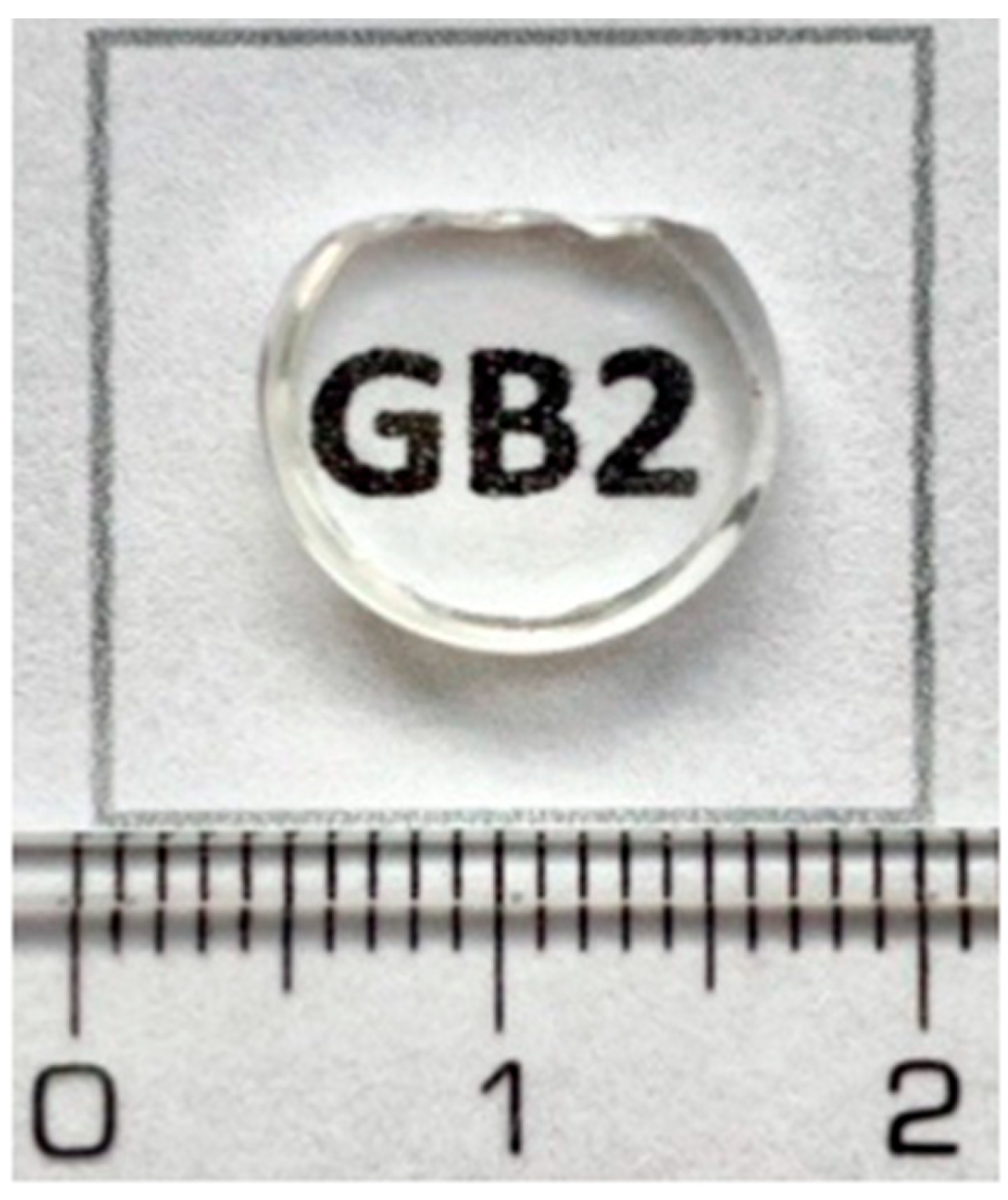
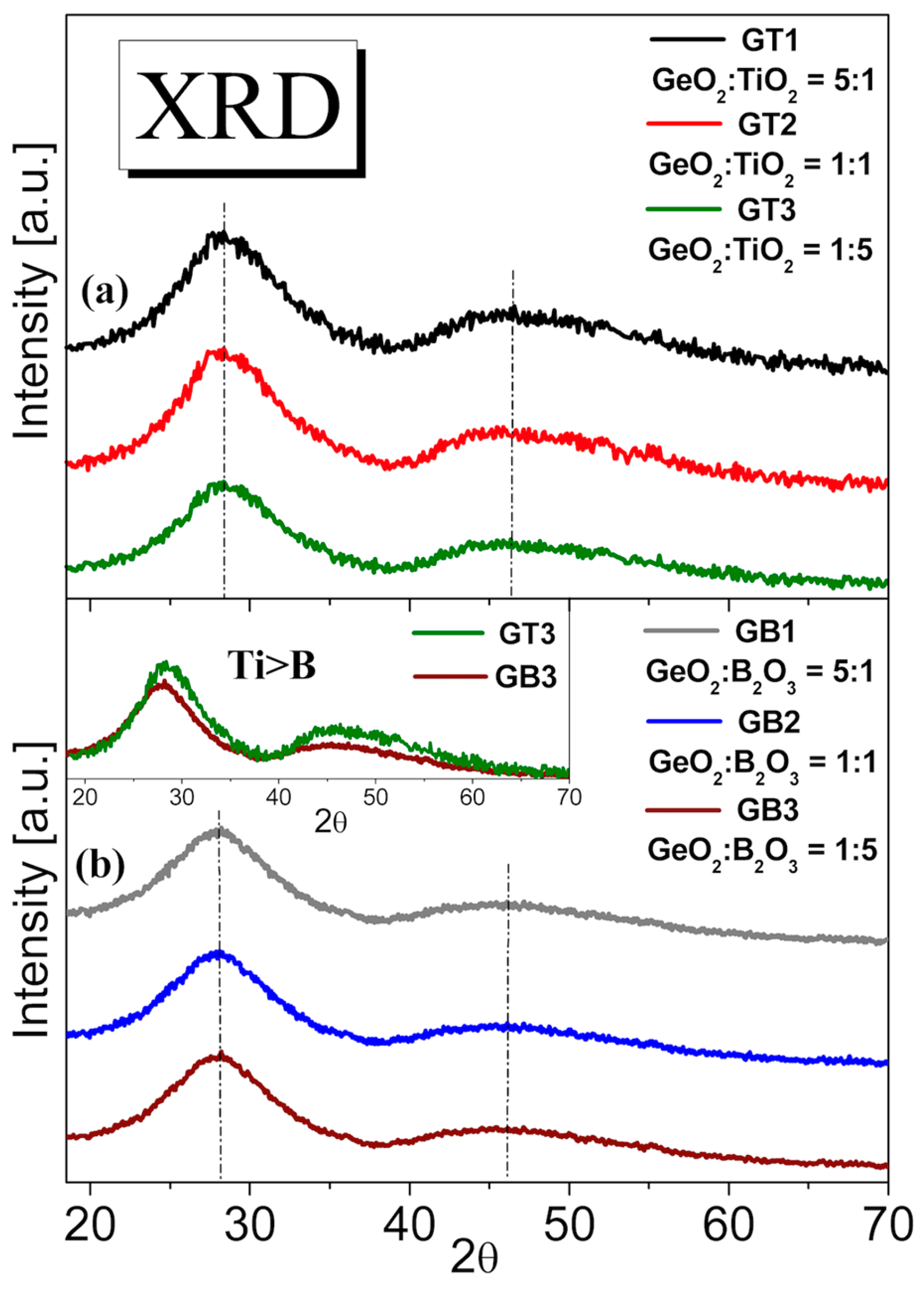
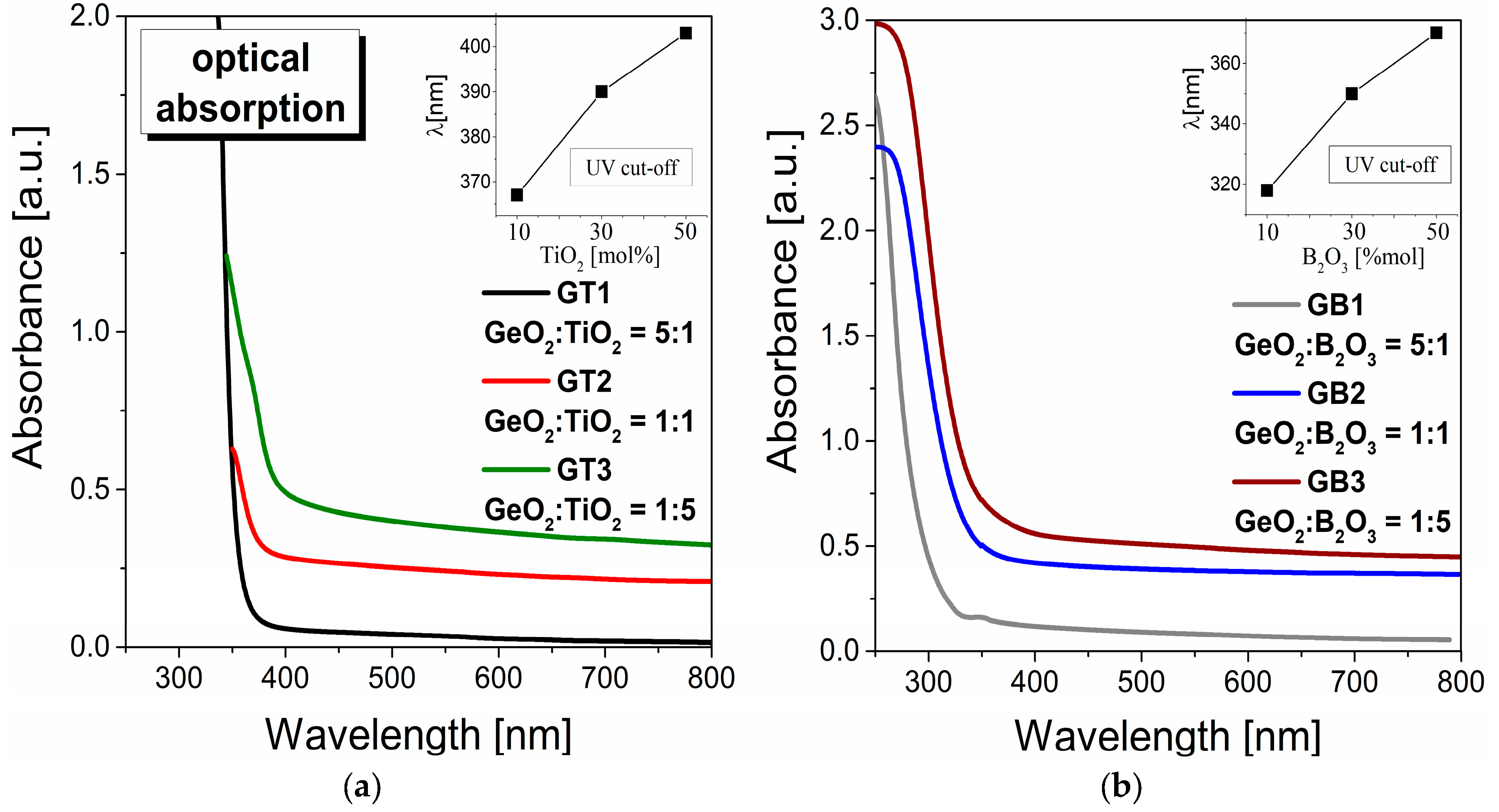
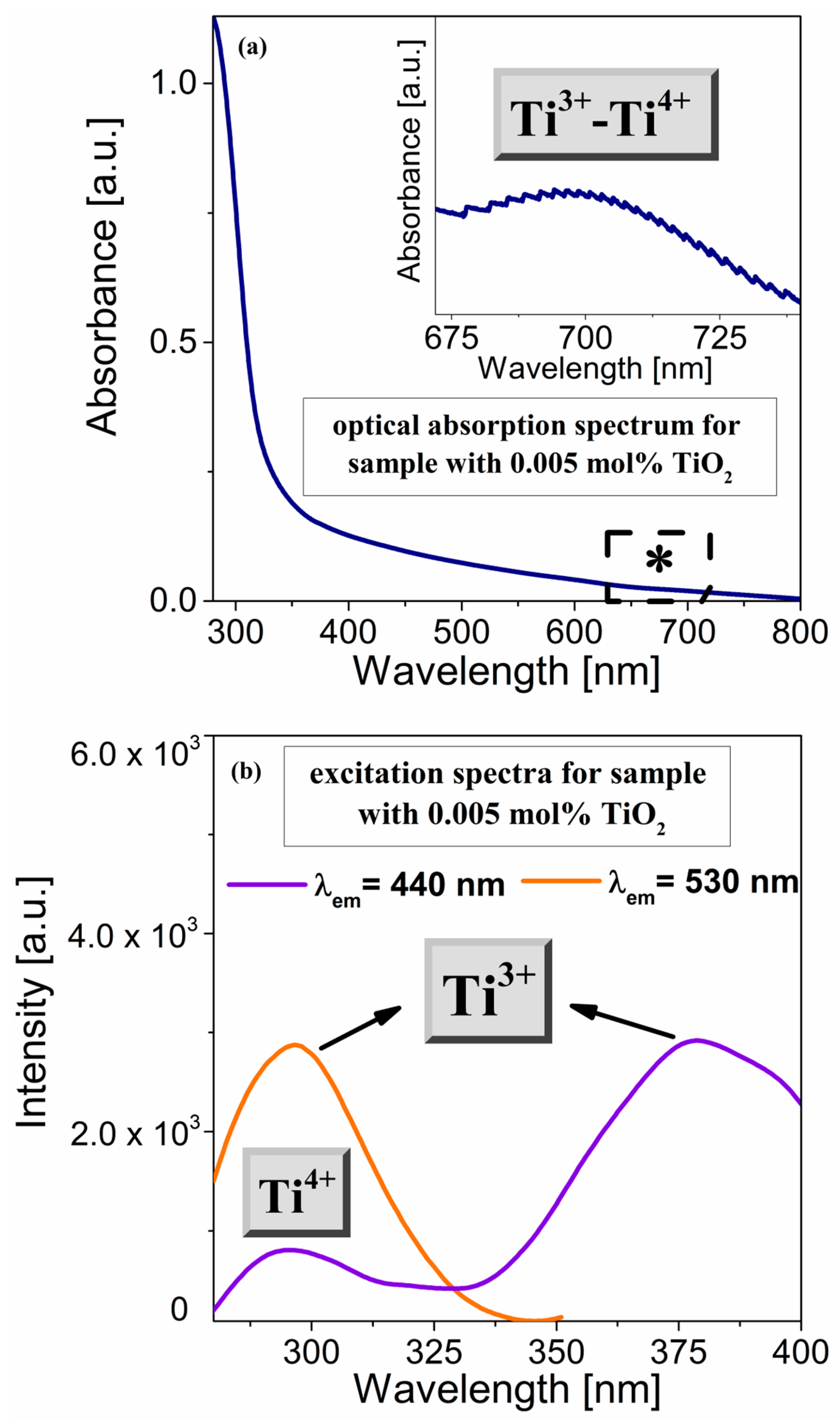


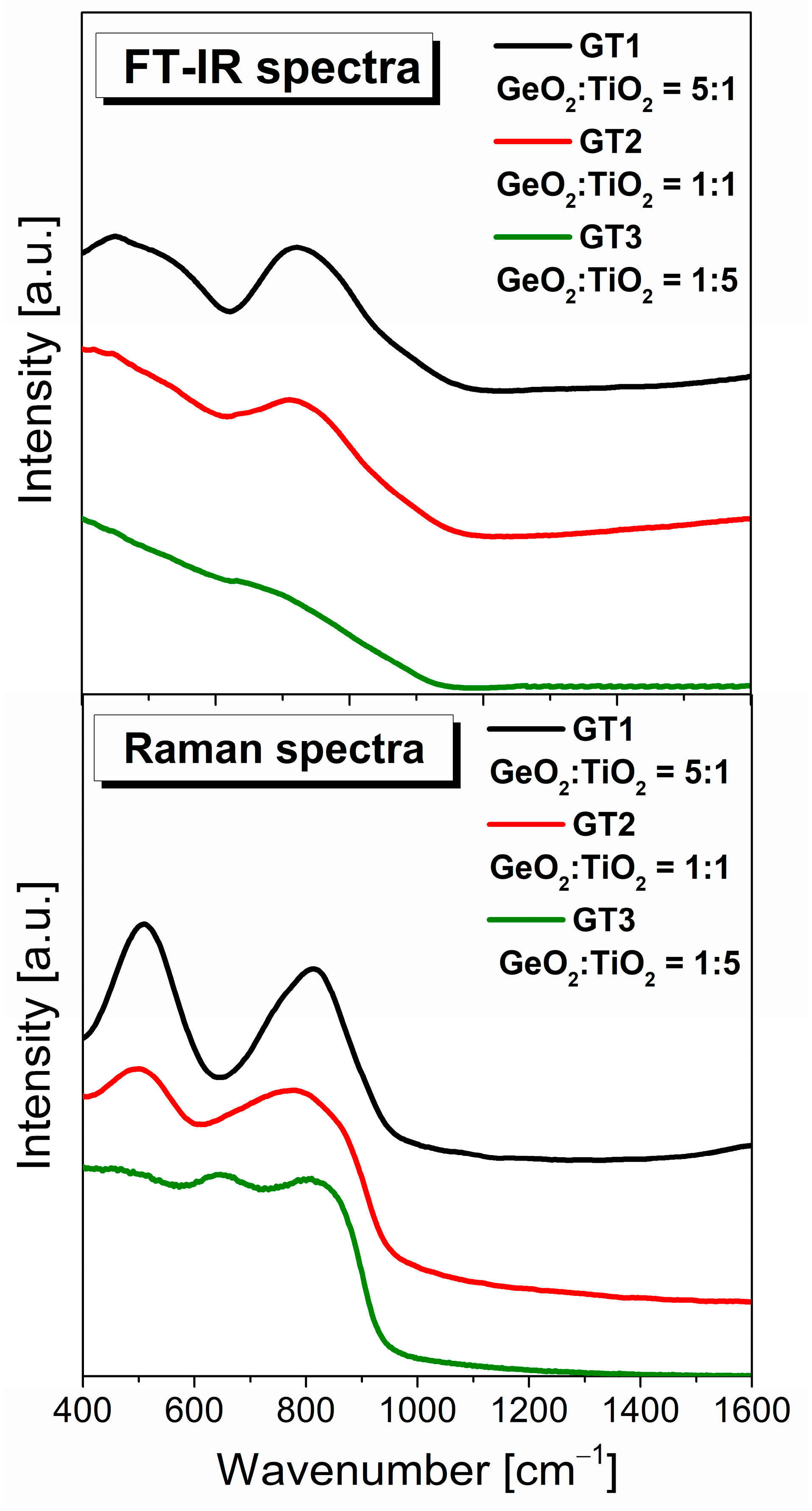
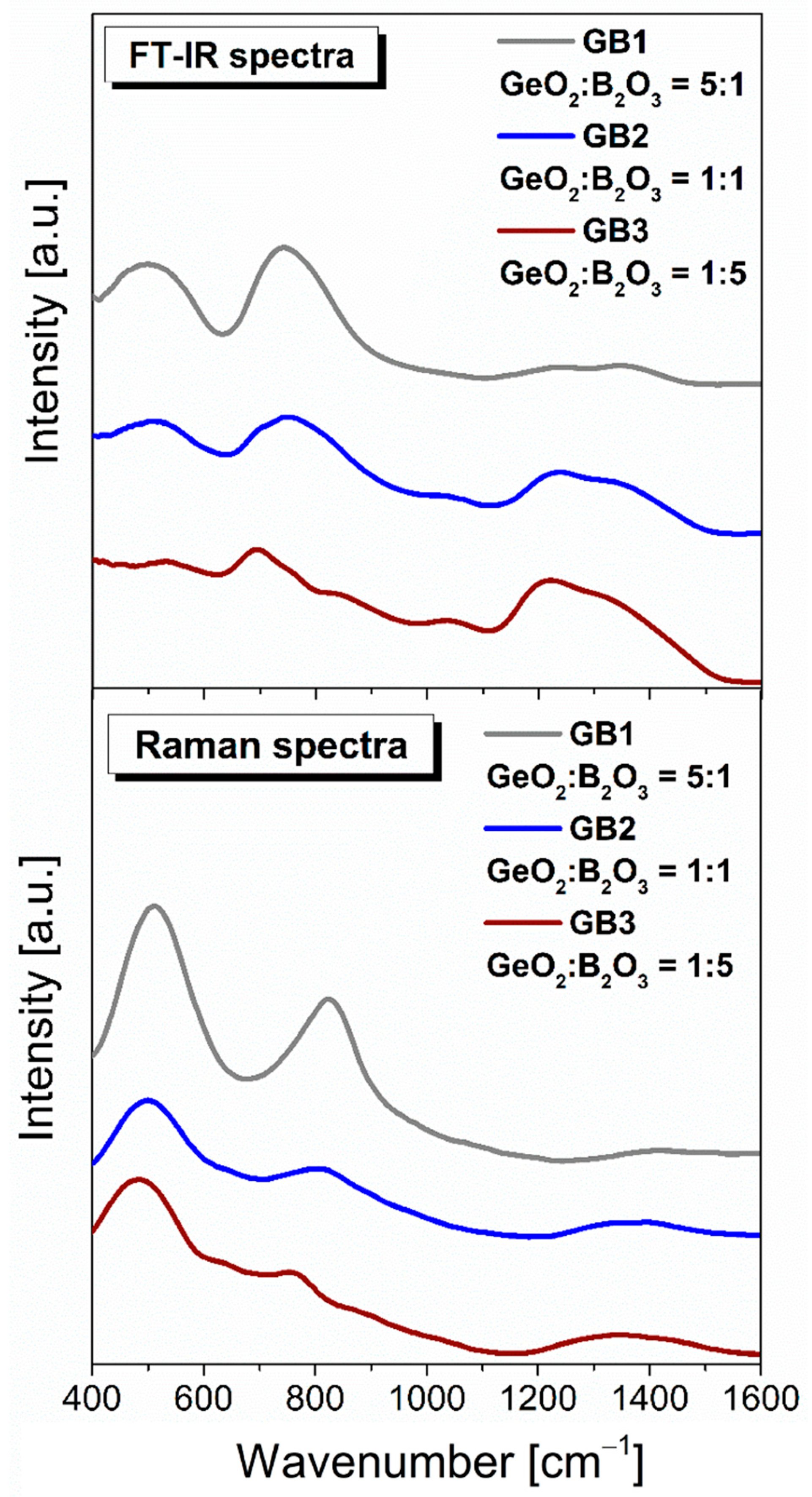
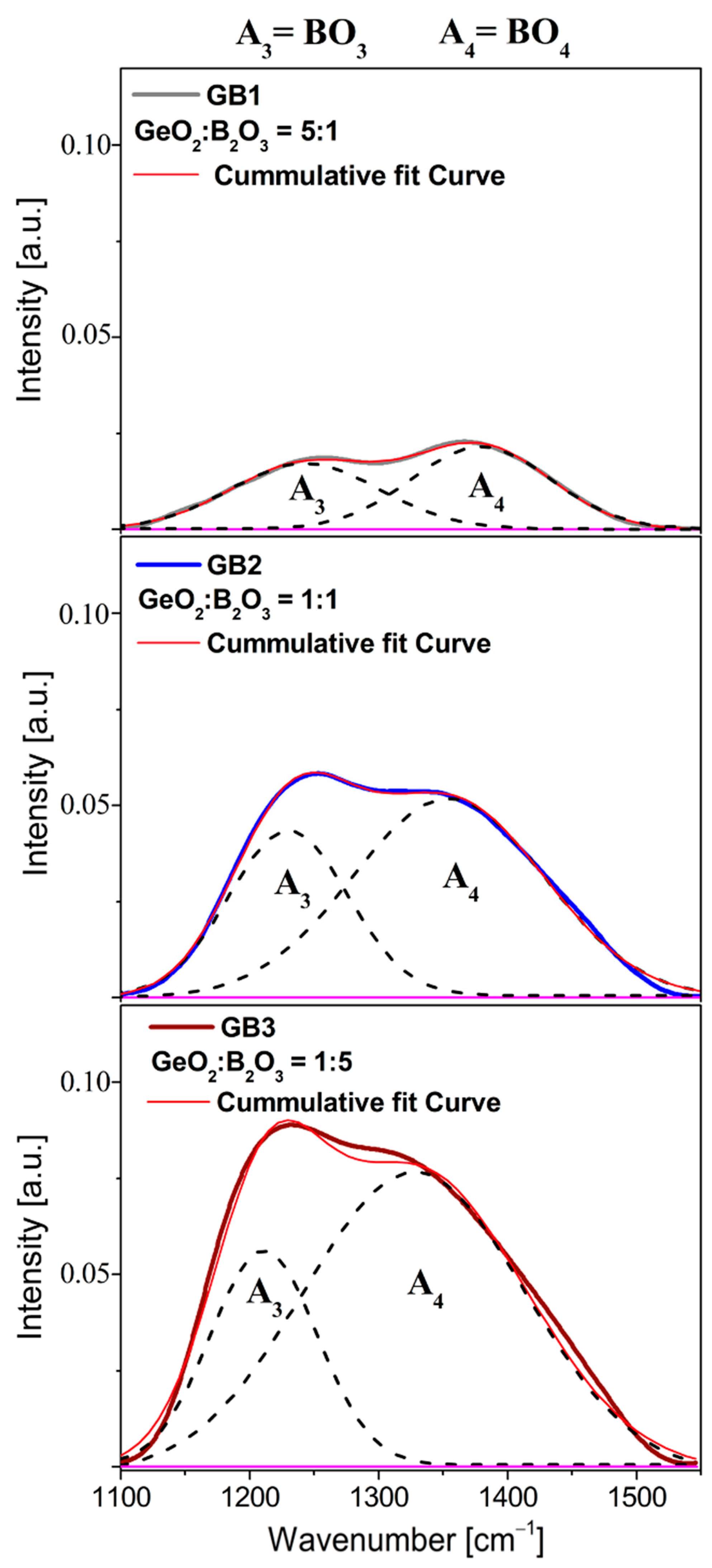
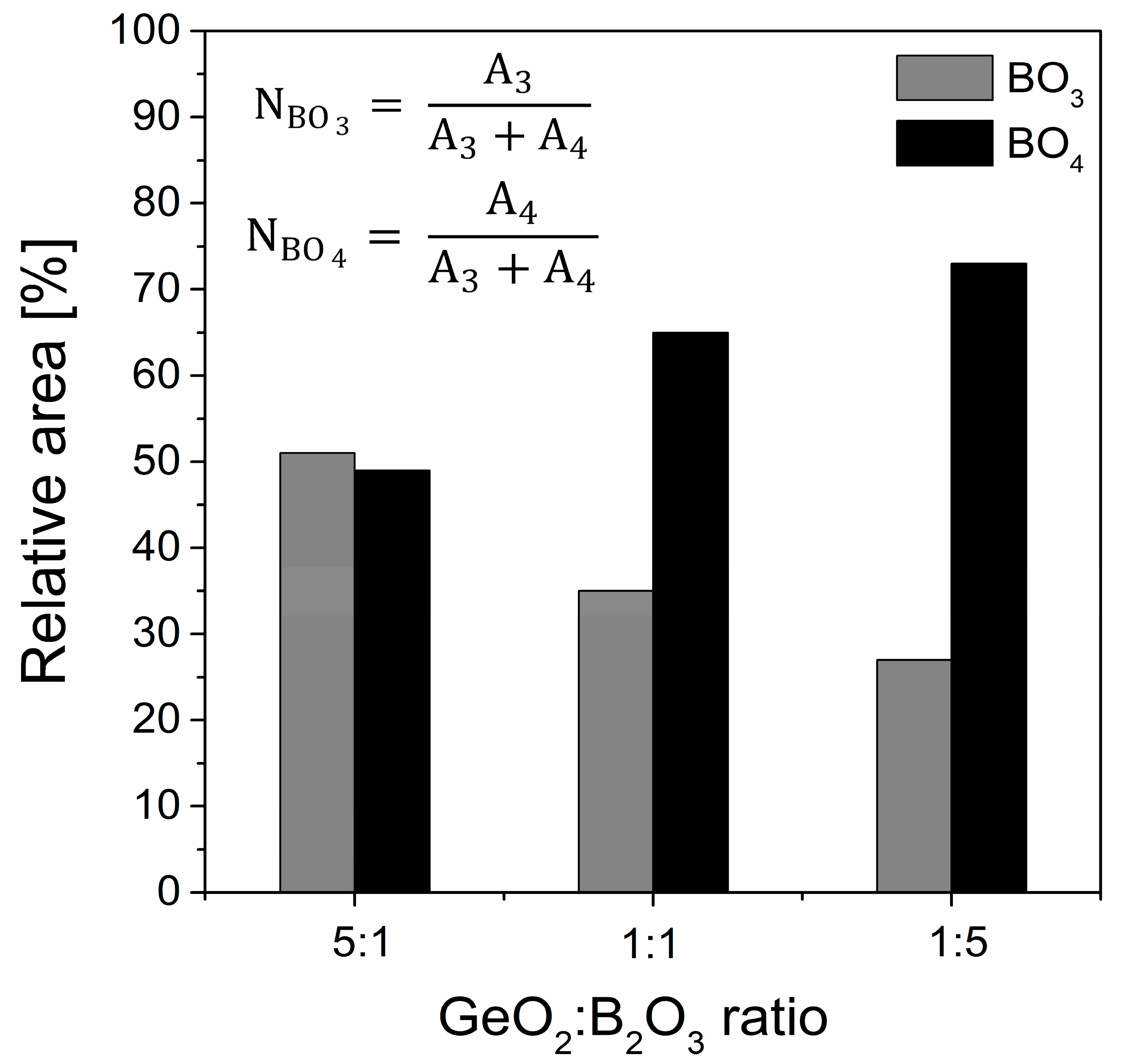
| Chemical Composition of BGG Glass with TiO2 (mol%) | |||||
|---|---|---|---|---|---|
| Sample Code | GeO2 | TiO2 | BaO | Ga2O3 | GeO2:TiO2 |
| GT1 | 50 | 10 | 30 | 10 | 5:1 |
| GT2 | 30 | 30 | 30 | 10 | 1:1 |
| GT3 | 10 | 50 | 30 | 10 | 1:5 |
| Chemical Composition of BGG Glass with B2O3 (mol%) | |||||
|---|---|---|---|---|---|
| Sample Code | GeO2 | B2O3 | BaO | Ga2O3 | GeO2:B2O3 |
| GB1 | 50 | 10 | 30 | 10 | 5:1 |
| GB2 | 30 | 30 | 30 | 10 | 1:1 |
| GB3 | 10 | 50 | 30 | 10 | 1:5 |
Disclaimer/Publisher’s Note: The statements, opinions and data contained in all publications are solely those of the individual author(s) and contributor(s) and not of MDPI and/or the editor(s). MDPI and/or the editor(s) disclaim responsibility for any injury to people or property resulting from any ideas, methods, instructions or products referred to in the content. |
© 2023 by the authors. Licensee MDPI, Basel, Switzerland. This article is an open access article distributed under the terms and conditions of the Creative Commons Attribution (CC BY) license (https://creativecommons.org/licenses/by/4.0/).
Share and Cite
Kowalska, K.; Kuwik, M.; Pisarska, J.; Sitarz, M.; Pisarski, W.A. Raman and Infrared Spectroscopy of Barium-Gallo Germanate Glasses Containing B2O3/TiO2. Materials 2023, 16, 1516. https://doi.org/10.3390/ma16041516
Kowalska K, Kuwik M, Pisarska J, Sitarz M, Pisarski WA. Raman and Infrared Spectroscopy of Barium-Gallo Germanate Glasses Containing B2O3/TiO2. Materials. 2023; 16(4):1516. https://doi.org/10.3390/ma16041516
Chicago/Turabian StyleKowalska, Karolina, Marta Kuwik, Joanna Pisarska, Maciej Sitarz, and Wojciech A. Pisarski. 2023. "Raman and Infrared Spectroscopy of Barium-Gallo Germanate Glasses Containing B2O3/TiO2" Materials 16, no. 4: 1516. https://doi.org/10.3390/ma16041516
APA StyleKowalska, K., Kuwik, M., Pisarska, J., Sitarz, M., & Pisarski, W. A. (2023). Raman and Infrared Spectroscopy of Barium-Gallo Germanate Glasses Containing B2O3/TiO2. Materials, 16(4), 1516. https://doi.org/10.3390/ma16041516








